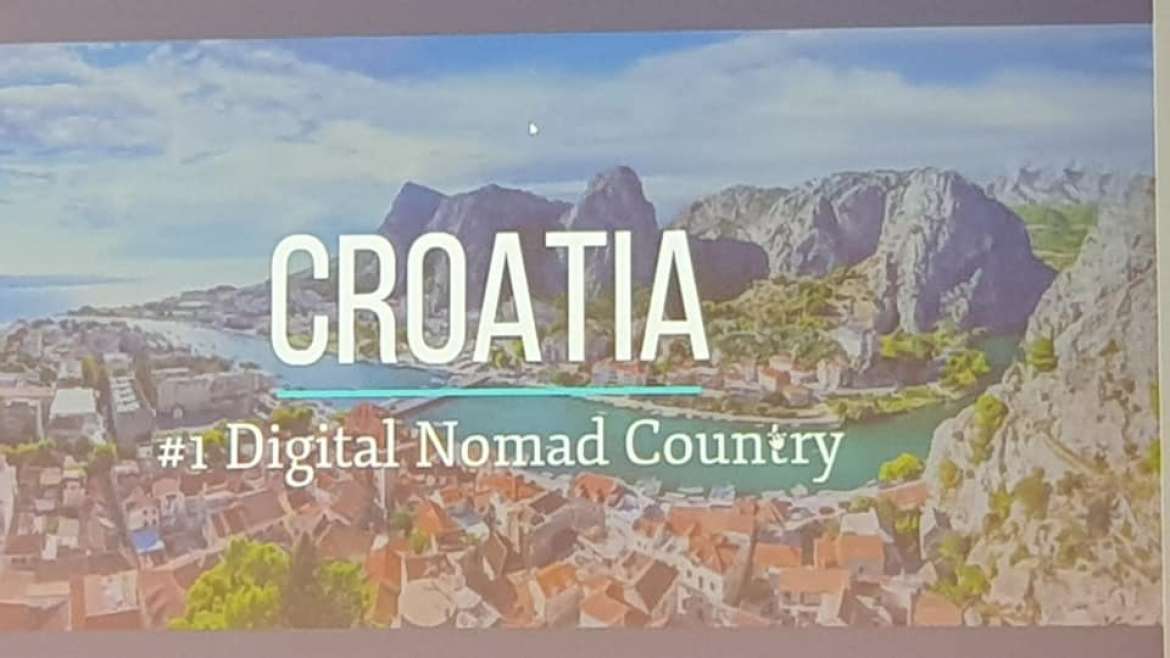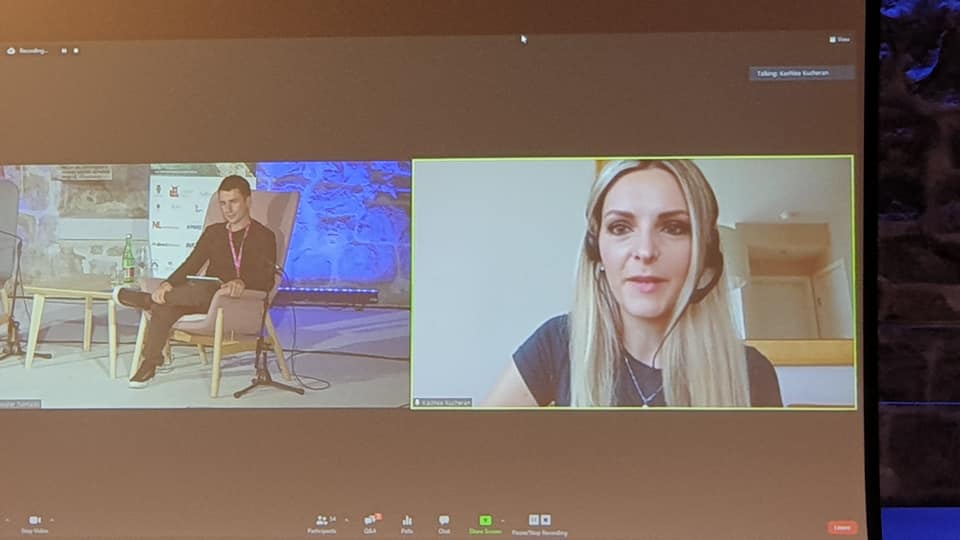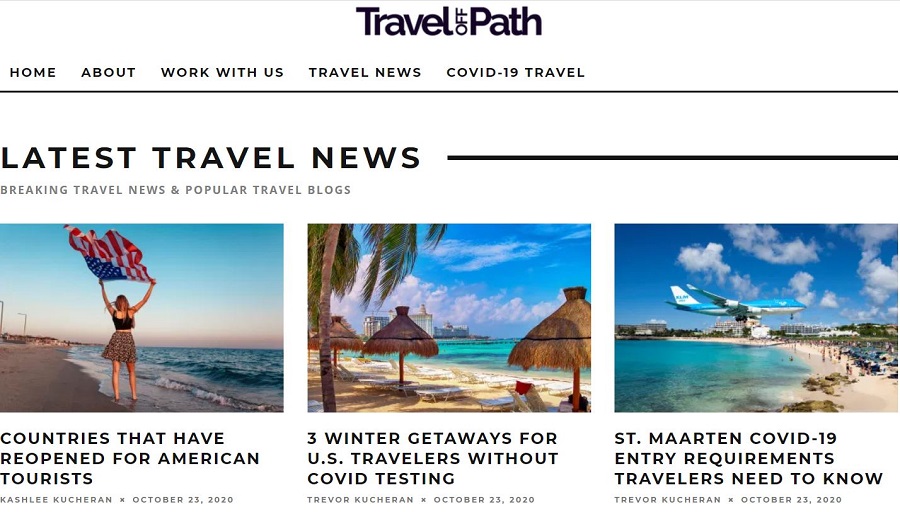Flights to Croatia: Aegean Returns to Three Croatian Airports Next Spring
November 25, 2020 - The latest news for flights to Croatia as Aegean returns to three Croatian airports next spring.
Croatian Aviation reports that Greek national airline Aegean Airlines has announced its return to Croatian airports next year.
Aegean Airlines did not operate to Croatian airports this year. In the original plan, before the outbreak of the global pandemic, they planned to operate to Zagreb, Split, and Dubrovnik, but all flights were canceled in April for this year.
The airline then completely withdrew from selling all routes to Croatia for the summer flight schedule in 2021, so at one point, the Aegean Airlines return to Croatian airports was questionable. The worst-case scenario, however, will not materialize - the Greek airline has returned three routes for sale; from Athens to Dubrovnik, Split, and Zagreb.
In the peak of the 2021 summer season, Aegean Airlines announces 22 weeks of flights to and from Croatia!
On all routes to Croatia, Aegean Airlines is announcing aircraft from the A320 family, which will lead to an increase in capacity, given that in the summer flight schedule in 2019, a certain number of flights were operated by DashQ400 aircraft.
Athens - Zagreb
Aegean Airlines introduced the Athens-Zagreb-Athens route in May 2018, operating on it with the mentioned DashQ400 aircraft 3 times a week. Although the line was supposed to operate only in the summer flight schedule, the company left it in traffic in the winter as well, with two flights a week, except in January and February when it was briefly interrupted due to low demand. In the summer of 2019, this line operated four times a week, which was the plan for the summer of this year, but with larger aircraft from the A320 family.
Aegean Airlines has released tickets on this route for the summer of next year. It will be in operation from the very beginning of the summer flight schedule, on March 31, and the flights are on sale until the end of October, more precisely, on October 30, 2021.
On the route between Zagreb and Athens, two flights a week will be available, every Wednesday and Saturday, on A319 aircraft, which have a significantly higher capacity compared to the DashQ400 (144 versus 78 seats).
Thus, in the summer of 2021, Aegean Airlines will offer as many as 17,856 seats between Athens and Zagreb!
Although the capacity is significantly higher due to the change in aircraft type compared to 2019, while the number of weekly flights has been reduced, the total number of seats offered between the two capitals will be only slightly reduced. The planes will operate on this line in the morning. Arrival in Zagreb is planned at 09 hours and 5 minutes, and departure to Athens at 9 hours and 50 minutes.
Athens - Split
Aegean launched the line to Split in the summer of 2016 and has been systematically increasing its capacity ever since, mostly increasing the number of weekly flights. For example, in the summer of 2018, this line had four flights a week, while in the summer of 2019, a fifth flight was added. DashQ400 aircraft operated on the route.
In the summer of 2021, Aegean Airlines announces four flights a week on the Athens-Split-Athens route. The line will operate from May 18 to October 7, 2021, with A319 aircraft that have the already mentioned capacity of 144 passengers in the fleet of this carrier.
Split and Athens will be connected by direct flights on Mondays, Tuesdays, Thursdays, and Fridays; on Mondays and Fridays in the afternoon, and Tuesdays and Thursdays in the morning.
Given that there is a change in the type of aircraft on this route, and consequently a significantly higher capacity on each flight to and from Split Airport, Aegean Airlines will have almost 24 thousand seats on sale in the summer of 2021!
Athens - Dubrovnik
Aegean introduced the line to Dubrovnik in the summer of 2015, continuously increasing the number of weekly flights from season to season, just as is the case with the line to Split. In the peak summer season in 2019, the line operated 5 times a week, with A320 and DashQ400 aircraft.
The Greek airline plans to restart this route as early as March 29, 2021, starting with two flights a week, Mondays and Saturdays. From May 20, the third flight is added weekly, every Thursday, and from June 4, flights on Fridays and Sundays.
Aegean will thus increase its capacity to Dubrovnik, considering that A319 and A320 aircraft were announced on the flights, while in the summer of 2019, smaller capacity aircraft - DashQ400 - also operated on the route.
The line to Dubrovnik will be reduced in the postseason. Namely, from September 30 to October 30, it should operate three times a week, on Mondays, Thursdays, and Saturdays.
Aegean will monitor the status of bookings on all routes and, if necessary, react by increasing weekly flights in the next summer season, with Zagreb having the best chances for another flight per week.
In addition to a direct line to Athens, Aegean has a wide network of destinations throughout Greece in its fleet. Given that an increasing number of Croatian citizens spend their summer holidays in Greece, destinations such as Heraklion, Chania, Santorini, Karpathos, Rhodes, Kos, and others should be easily accessible again next summer!
For the latest travel info, bookmark our main travel info article, which is updated daily.
Read the Croatian Travel Update in your language - now available in 24 languages.
Rethinking Dubrovnik Tourism in the Post-Covid Market
November 13, 2020 - TCN is delighted to welcome Dubrovnik native and tour guide par excellence Bozidar Jukic. Here is his first piece on rethinking Dubrovnik tourism.
My number one favourite mundane item is a blank sheet of paper. Ever since I was a child I loved drawing and sketching. Later on this turned into a passion for graphic design and writing. To this day written word is something I find to be incredibly important in my life. All of these creative activities have one thing in common – they each start off with you staring at a blank sheet of paper. This pristine white rectangle has the potential of being turned into an important piece of art or text with enough power to change the world.
It doesn't take much imagination for a tourism professional to translate this metaphor to currently empty streets of Dubrovnik's historical centre. It is the start of November and I can’t help feeling sad looking back at what should have been a successful 2020 tourism season. For well-known reasons, most people decided against travelling internationally this year and Dubrovnik’s tourism, based mostly on guests flying into the destination, took a big hit. Usually, early autumn is my favourite time of the year. Those who visit Dubrovnik during this time usually leave feeling very happy they've decided to skip summer months which have recently been offering too few benefits to efficiently counter the downside of crowded streets and beaches. In 2020 October saw Dubrovnik streets almost completely empty and many local businesses closing for the year in anticipation of a very uncertain 2021. These empty, stone-cobbled streets are a blank piece of paper of sorts as well. They may represent emptiness at the moment, but they also provide endless opportunity.
I’ve had a chance to talk to Mr. Ryan Pyle who’s filming what promises to be a very cool travel series for Amazon Prime called “Nomad”. He was visiting Dubrovnik last week and we did a short interview. One of the questions he asked me was about the opportunity of rebranding Dubrovnik post Covid-19 induced disruption in business. It got me thinking about what we should do and more importantly, whether we will have the will to do it.
I've written a few times about sustainability in Dubrovnik's tourism or lack-there-of. It would be too repetitive for me to once again lament over what overtourism is doing to this city in the long run. Let’s just boil it down to four major problems: pollution, overcrowded city, degradation of tourism offer as it panders to short visit guests, loss of local culture as the costs of running a small business in the city skyrocket. It seems like such a simple problem to define, but somehow we make it seem impossible to solve, year after year.
Summer of 2020 brought no problems with overcrowding, traffic jams, or overcrowded city streets. Instead, we’ve lived through what seems to have been the eye of the storm in a global pandemic whose real effects we are still to discover, but are already dreading. For most local business owners thinking about the positive side to this crisis is difficult. Still, it is imperative to look forward and try to imagine what comes next and how to make the most out of this difficult situation.
Truth is, Dubrovnik can be anything we make it out to be. Main thing to understand is that a choice needs to be made. So far, we’ve been pumping up numbers and exploring all the avenues that ensured money coming in. Good, we’ve made it. Money is coming in. Now, we need to see how not to destroy what makes this place so wonderful to live in and visit. I hope we steer our city in the direction of a new breed of tourism. One that is sustainable and will not only be less destructive, but one that will see local community wanting to be a part of it. For this, the key is to attract guests looking for longer stays. We need to strategically lessen the number of people coming to Dubrovnik for one day trips or for a single night stays. When guests are spending multiple days in Dubrovnik, it gets much easier to interest them in exploring the city’s offer in more depth. They get to see the other parts of Dubrovnik-Neretva County, most of which are grossly undervalued by travel businesses. They get to be introduced to the local culture and way of life. They also get to discover authentic products and services that often cannot be found in the main touristy areas. Longer stay means more immersion into “Dubrovnik the Community”, not just a brief visit to “Theme Park Dubrovnik”. It means creating stronger ties between the guest and local community and this in turn creates less market for tourist traps and more demand for quality.
Every crisis is an opportunity. It is time for re-shuffling of cards and re-evaluating our positions. With a long winter and perhaps even a new lockdown upon us, it is a perfect time to have this conversation. What do we do next, my neighbours from the “Pearl of the Adriatic”? What is the Dubrovnik our kids will know?
You can learn more about Bozidar's tours on his official website, Insider Holidays - Wine & Food Tours to Discover Croatia.
Flights to Croatia: Brussels Airlines Plans Three Croatian Destinations Next Summer
November 9, 2020 - The latest news for flights to Croatia as Brussels Airlines plans three Croatian destinations next summer.
Croatian Aviation reports that in the 2021 summer flight schedule, Brussels Airlines plans to operate to three Croatian destinations.
Namely, the Belgian national airline, which normally operates to more than 100 destinations worldwide, plans to operate to Zagreb, Split, and Dubrovnik next year.
In the summer flight schedule, which ended at the end of October, Brussels Airlines operated to Split and Dubrovnik.
The line to Split started operations at the beginning of July, while the line to Dubrovnik was in traffic from June 27. Both lines operated with reduced flights compared to 2019. The airline temporarily canceled the lines to Zagreb and Zadar, and they did not operate this summer season.
The Brussels Airlines route to Zagreb was introduced in 2015, while the route to Zadar was introduced in the summer of 2018.
In the summer flight schedule next year, Brussels Airlines plans to operate from its headquarters in Brussels to Zagreb, Split, and Dubrovnik. The line to Zadar is currently not for sale.
The Brussels - Zagreb line will operate from March 28 to October 29, 2021, 5 times a week, every Monday, Wednesday, Thursday, Friday, and Sunday.
Brussels 13:20 - 15:10 Zagreb 15:50 - 17:45 Brussels
The seasonal line to Split should operate from the end of April (April 24), while the Brussels - Dubrovnik line will operate from May 1 next year.
The return of Brussels Airlines to Zagreb next spring is good news for passengers who want to continue their journey to several destinations in Europe with this airline. Until March 2021, direct flights from Zagreb to Brussels are available with the national airline - Croatia Airlines.
For the latest travel info, bookmark our main travel info article, which is updated daily.
Read the Croatian Travel Update in your language - now available in 24 languages.
NASA Shows Which Southern Croatian City Should Fear Flooding Most
November the 4th, 2020 - It might seem like a bit of a stupid thing to say, as surely anyone and everyone should fear being flooded as climate change continues to alter the weather in ways we often struggle to cope properly with. Which Croatian city, however, should fear it the most? One southern Croatian city which is wildly popular with tourists and is also UNESCO protected should fear becoming submerged more than any other in the rest of the country.
The word Dubrovnik likely stirs up an array of pleasant memoris for all those who have visited, along with perhaps a traffic jam and an expensive coffee too many, maybe. Residents of this southern Croatian city should have more on their minds than crowds of tourists in shops on hot August days, however, and flooding is one of the more serious of them.
As Poslovni Dnevnik writes, just how serious this problem could be for Croatia's tourism Mecca can be seen very well with the help of a tool designed by no less than NASA, which predicts which cities will end up flooded and even totally submerged due to the melting of glaciers caused by the ongoing threat of climate change across the planet, reports Vecernji list.
Scientists have put the effect of the Earth's gravity and its rotation into a special "formula" in order to predict how water will be end up being "redistributed" around the world as climate change progresses.
"The tool for each city provides a clear picture of which glaciers are of particular importance," one of the scientists involved in the study explained to the BBC.
Research has shown that the melting of large ice sheets in western Greenland, dangerously close to Europe, should be feared. Along with the major European capital of London, Tromso, Oslo, Athens, Syracuse, Marseille, Gibraltar, Brest and the southern Croatian city of Dubrovnik should be greatly concerned about what this could mean for them.
Scientific datas show that melting glaciers had an impact on sea level rise during the 20th century, and in the 21st century that impact has increased even more.
For the latest travel info, bookmark our main travel info article, which is updated daily.
Read the Croatian Travel Update in your language - now available in 24 languages
Flights to Croatia: Vueling Returns to Dubrovnik in January, Transavia Completes Services to Croatia
October 30, 2020 - The latest news for flights to Croatia as Vueling returns to Dubrovnik in January, and Transavia completes services to Split and Dubrovnik for this year.
Croatian Aviation reports that Spanish low-cost airline Vueling plans to return to Dubrovnik Airport in January 2021.
At the end of the summer flight schedule, the company suspended traffic to all Croatian airports, and Dubrovnik is currently the only planned destination in Croatia in the winter months.
This summer, Vueling flew to Zagreb, Split, and Dubrovnik, with reduced flights compared to last year's summer flight schedule.
Vueling plans to re-establish the Barcelona-Dubrovnik line starting in 2021. Regular flights between the two cities are currently announced from Sunday, January 3, 2021, twice a week, every Thursday and Sunday.
The line should operate until the end of the winter flight schedule (March 28, 2021) with the above two flights per week, and for the summer flight schedule next year, the company currently has daily flights on this line.
The realization of these flights will primarily depend on the global situation with COVID-19, which directly affects the demand itself, so Vueling will cancel the announced flights in case of commercial unprofitability.
Vueling announced flights to four Croatian airports for the next summer season; Zagreb, Zadar, Split, and Dubrovnik, but we will know more about the summer flight schedule later, as it is too early to conclude so many months in advance, especially in these uncertain times.
Vueling's intention to operate on the Barcelona-Dubrovnik route in the winter flight schedule is certainly positive news, but the question remains: Will there be demand?
Furthermore, Croatian Aviation reports that low-cost Dutch airline Transavia, a subsidiary of the world's oldest airline, KLM, and also a member of the Air France - KLM group, will perform the last flights to Croatian airports for this year this weekend.
Transavia had reduced traffic to Pula, Rijeka, Zadar, Split, and Dubrovnik this summer, connecting five Croatian airports with destinations in France and the Netherlands, despite reduced demand.
The company cut traffic to Rijeka, Pula, and Zadar in September, and Transavia operated only to Split and Dubrovnik in October with a relatively small number of weekly flights.
The Split - Paris Orly line operated 2 to 3 times a week in October, and on Friday, October 30, the company will perform the last flight to Split on the line from Orly.
In Dubrovnik, Transavia had two active lines this month, from Nantes and Paris. These two lines will end with traffic for this year, a day later compared to Split, on Saturday, October 31.
In October, two routes from France to Dubrovnik operated with a minimum weekly frequency, only once a week, on Saturdays. Still, all routes were operated by B737-800 aircraft with a capacity of as many as 189 seats in the carrier's fleet.
Transavia will no longer have regular operations at Croatian airports after the last weekend in October, and re-establishing numerous seasonal routes is expected in mid-April next year. This low-cost carrier has not operated to Croatian airports in winter before, and Transavia will not operate to neighboring airports (Ljubljana and Belgrade) in the winter months.
For the latest travel info, bookmark our main travel info article, which is updated daily.
Read the Croatian Travel Update in your language - now available in 24 languages.
Join the Total Croatia Travel INFO Viber community.
From Overtourism to Undertourism: CNN on the Future of Dubrovnik
October 29, 2020 - From excessive tourism to empty streets and pandemic blues, CNN reports on the future of Dubrovnik.
Jutarnji List and CNN report that the term “overtourism” was often used last year to describe scenes that could be seen on the hiking trails of Machu Picchu or the streets and canals of Venice. The mentioned destinations and many others wrestled every day with crowds of tourists who wanted to experience a place's natural beauties and cultural goods.
Then came 2020 and the coronavirus pandemic.
No plan, forecast, and projection of tourism experts included the possibility that the sector would crumble and fight for survival. As COVID-19 spread around the world, bans on movement and quarantine forced people to stay at home.
CNN, therefore, wonders: Is overtourism a thing of the past?
To get an answer to this question, CNN contacted destinations that had suffered from this type of tourism before the pandemic. Dubrovnik is a perfect example.
The sea of terracotta roofs, city walls, and connection to the TV series "Game of Thrones" led to a significant increase in the number of tourists who visit Dubrovnik every year. Next to tourists enjoying the Adriatic Pearl for an extended weekend are those who came to the city on cruise ships and will leave by the end of the day.
As the crowds grew larger and larger from year to year, Mayor Mato Franković and other city officials promised to bring the situation under control. Last year, the number of cruisers allowed to dock in the old city port was limited to two, 80 percent of souvenir shops were closed, and it was proposed to ban the opening of new outdoor restaurants.
In early 2020, officials wondered if the measures would bear fruit.
The pandemic, which hit Europe hard in March, led to the decision to close the borders, and tourists stopped coming.
When Dubrovnik reopened at the beginning of the summer, and when tourism started again, mostly Croats came to the city. International guests began arriving only when passengers were received at Cilipi Airport again. But it didn't take long as the number of people infected with the coronavirus began to rise again.
"The UK had put us on the quarantine list, and everything sank again. Airlines started to reduce the number of flights," Deputy Mayor Jelka Tepsic told CNN. "Dubrovnik without flights and without the British market achieves minimal numbers."
Local tourist guide Ivan Vukovic said he finds it strange to see Dubrovnik so quiet. Truth be told, he also says that a break from the crowds is good for him.
"The atmosphere during the summer is similar to that of the 1990s when the (Homeland) War was still raging. The only thing is that there is no shelling now," Vukovic told CNN.
Dubrovnik recovered from the war and became one of the world's most famous tourist destinations. The question now is whether the pandemic and the ensuing catastrophe can catalyze change.
Tepsic says the restriction on cruisers and other measures against overtourism will not be lifted when international airlines resume operation, and the city is ready to invite guests to return.
Dubrovnik wants to tell its future guests that it seriously wants to deal with the problems of excessive tourism and coronavirus.
"At the entrance to the Old Town, there is a large sign saying that everyone should wear masks, keep their distance and wash their hands and use disinfectants, and we have special rules within the 'Respect the City' program," said Tepsic.
Unlike many European destinations, Croatia allows Americans to come, but only if they have a negative PCR test for COVID-19 that is not older than 48 hours. The lack of flights makes it difficult for the vast majority to arrive, but those with access to private jets come to Dubrovnik.
Tepsic says the city will continue to focus on luxury tourism.
City officials and entrepreneurs want tourists to walk the city streets again, but they also want a sustainable future.
Vukovic says the goal is not to return to excessive tourism but "some kind of normal tourism, if at all possible."
You can read the full article on CNN.
For the latest travel info, bookmark our main travel info article, which is updated daily.
Read the Croatian Travel Update in your language - now available in 24 languages.
Croatia Through the Eyes of a Digital Nomad: Dubrovnik’s Lazareti Backstory Still Resonates
October 28, 2020 - Freelancers Week may be over, but digital nomads are still making connections with one another and with coworking spaces, including the historic Lazareti in Dubrovnik.
My first experience with European Freelancers Week (#EFWeek2020), which just wrapped up, was a whirlwind from beginning to end. I worked in three different coworking spaces, learned how to open and operate an obrt, and socialized with a group of fellow “remote” females. From all this networking, a new project landed on my plate and began the same week. Awesome! The most memorable experience though was working on a kick-off event—the Dubrovnik for Digital Nomads conference.
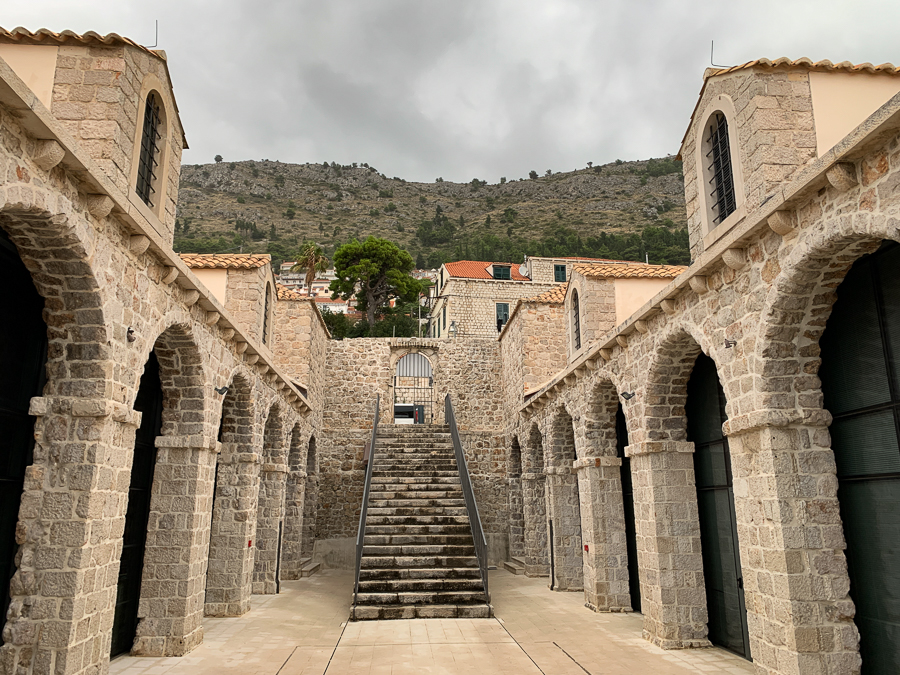
(When epidemics spread rampantly in the 14th and 15th centuries, the Dubrovnik Republic took strict measures to organize sanitary and public healthcare services throughout the region. It’s no coincidence that epidemics of infectious diseases erupted and the period was characterized by a boom in trade.)
Independent work and workspace
Freelancers Week, the parent of #EFWeek, is a celebration of independent professionals and coworking spaces. The conference delivered on both, as a salute to Croatia’s impending digital nomad visa and with an offer of free coworking for the week. The event and the coworking were located in a place of historic consequence—Dubrovnik’s famed Lazareti. Ths row of buildings on the city’s waterfront is notorious as a former quarantine site. Hello, pandemic?
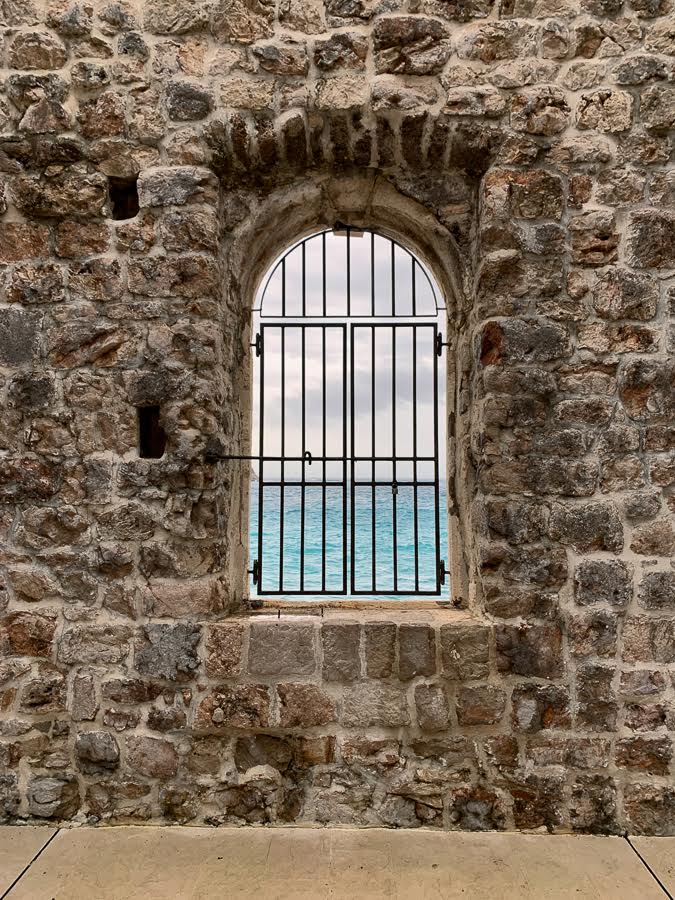
(Small windows in each courtyard were once doors where goods were unloaded from ships, directly into the lazaretto for holding.)
Quarantine origins
Poking around the buildings before the conference, I noticed an art exhibit on the walls. It was actually an illustrated account of the city’s quarantine origins. Dubrovnik was the first state in the world to institute an official quarantine system to protect its people against infectious diseases. “Our Lord God sent a terrible, unheard of judgment on the whole world…” The opening sentence of the prologue wasn’t exactly factual, but it got me wondering if the same God is in charge today, 600+ years after this story began. Don’t get me started…
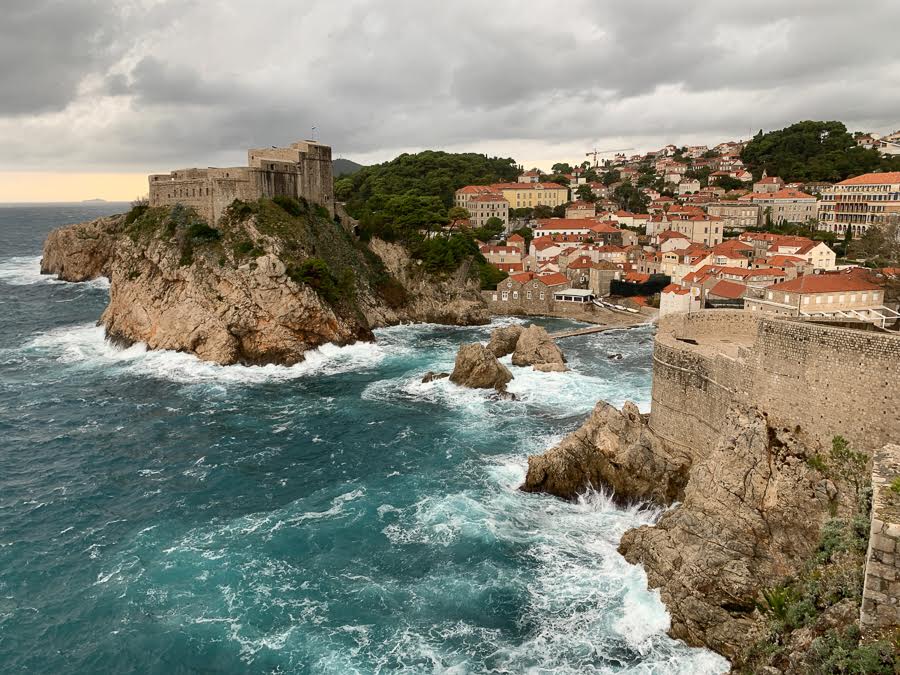
(People who received a prison sentence for violating quarantine restrictions were held at Lovrjenac Fortress, just outside Dubrovnik’s city walls and the Pile Gate.)
Epidemics across the Mediterranean
Raging plague and cholera epidemics were common from the 14th to 18th centuries across Europe and Asia. During these Middle Ages, Dubrovnik was a thriving maritime Republic that received people and goods from all over the world. In 1348, the Black Death plague decimated the population and killed roughly one-third of its citizens. Although infectious diseases were largely attributed to poor hygiene and poor nutrition, treatments were ineffective. It was thought that isolating people who were infected would stop the spread. Three decades later, in 1377, the Republic announced quarantine measures. They targeted all travelers, merchants, sailors, and goods arriving from "suspicious lands." An isolation period of 40-days was mandated and only when a person was proven healthy would they be allowed into the city.

(In 1795, drummers in the Dubrovnik republic publicly announced that subjects in exile should return home and report to quarantine. The Republic would pay 4 dinarić (silver coins) for every day of quarantine. Whoever ignored this would be sentenced to death. If he tried to flee, a price would be put on his head of 100 sequins (Venetian gold coins).)
Lazarettos
The first lazarettos—quarantine stations, were built on remote, uninhabited islands just off the coast—Bobara, Cavtat, Mrkan, and Supetar. Over time, as others were constructed on different islands, including Lokrum, they became complex institutions. Scribes, guards, gravediggers, cleaners, priests, barbers, and healthcare officers were employed. The latter implemented quarantine restrictions and supervised compliance. Penalties for rule-breakers ranged from fines (100 ducats), to prison sentences, severe corporal punishment, and the threat of being shot. Seamen and their families received special dispensation. Since sailors typically had to return to sea immediately after their quarantine, wives and families were allowed to join them and quarantine together at the lazarettos.
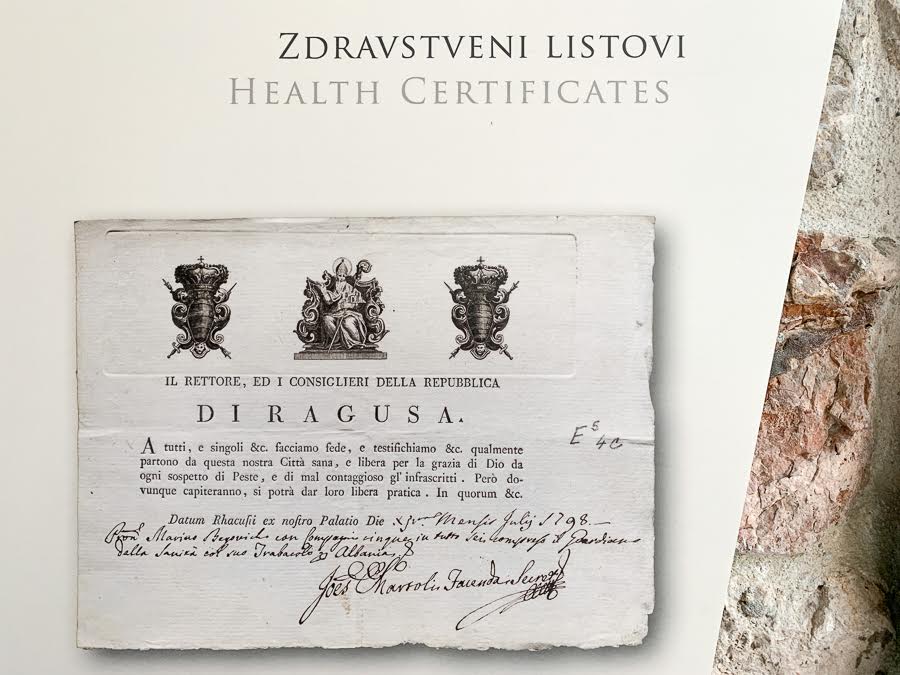
(In cooperation with the Health Office, the Republic issued health certificates to confirm that passengers in Dubrovnik had undergone the prescribed quarantine, or to state there was no infection in the area at the time of their travel.)
Safety measures
Reading about various safety measures—from hundreds of years ago mind you, they were surprisingly familiar. There was contact tracing, decontamination of food and animals, disinfection of ships and buildings, self-isolation, lockdown, border closure, contactless payment, distance rules, prohibition of public gatherings, and more. Contact tracing in the 1600s? Yep. People reported who they had contact with and also what they saw and heard about others. They snitched! Supposedly, it worked, and the plague of 1691 was snuffed out in three months. Contactless payment? Yes, again. Place your ducats on the counter and the person on the other side swept them into a drawer with a stick.
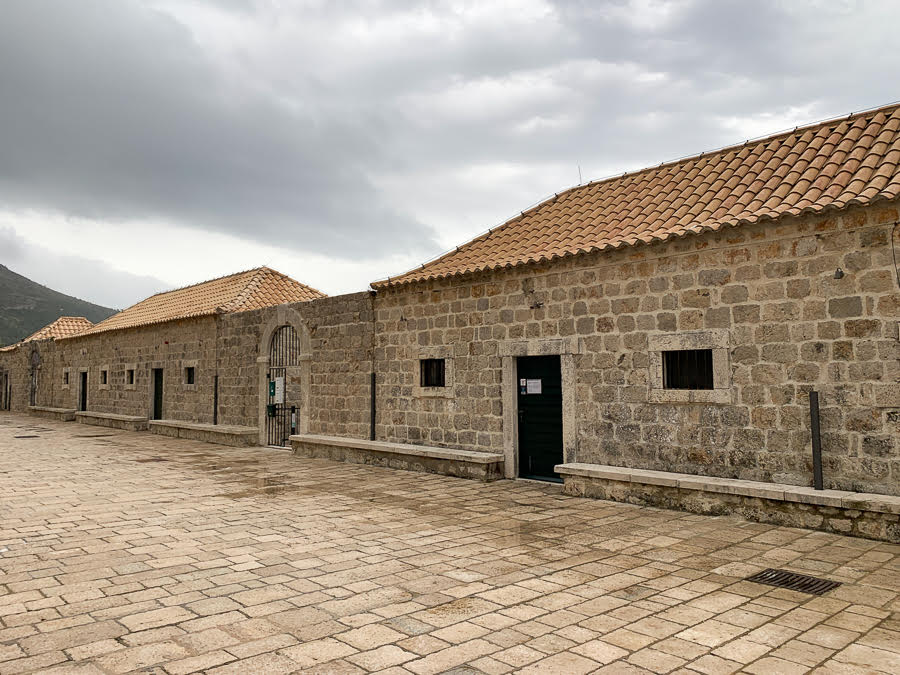
(Buildings along the upper courtyard of the lazaretto were once holding facilities for travelers to quarantine before embarking. Today they house various businesses and artistic ventures.)
Lazareti
The Lazareti, located near the Ploče Gate, was completed in 1647. Its location is significant—situated next to Dubrovnik’s old port and the city’s main entry point. As my feet walked through this multi-story lazaretto, consisting of eight buildings and five interconnecting courtyards, I noticed the architecture that once sheltered people, goods, and caravans from afar. From the shared, upper courtyard at street level, large staircases lead to the individual, lower courtyards at sea level. From the top of each staircase you get an expansive view of the sea, the city walls, and the old town. Peering down, a single, barred window in each courtyard gives you a sweet view of the water. This creates a neat “picture in picture” visual effect yet, standing next to the window there’s an immediate awareness of being behind bars. You’re on the inside looking out.
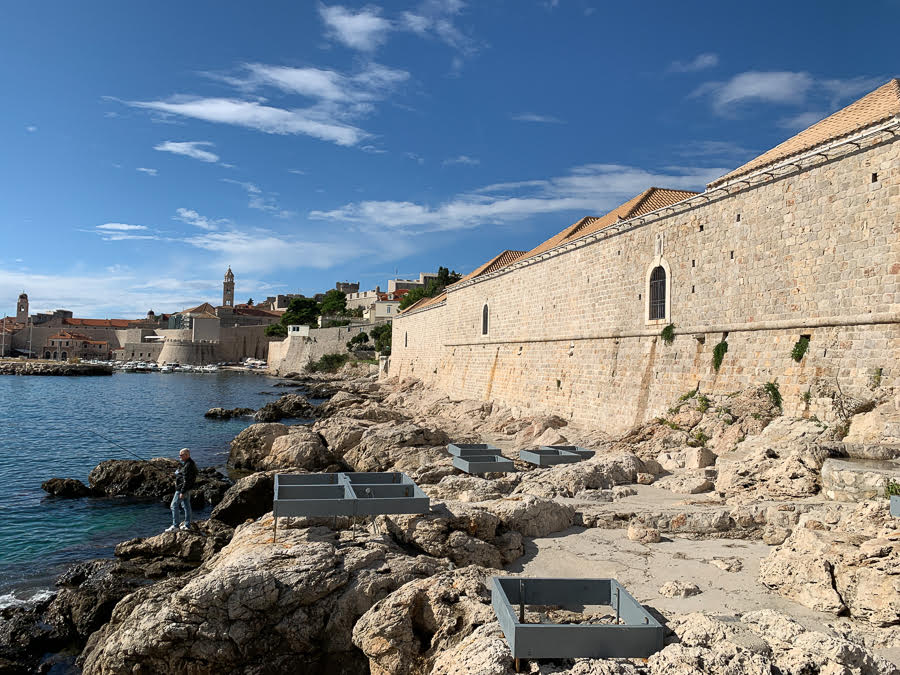
(The lazarettos, consisting of eight buildings and five courtyards, were renovated in 1623 from the sea side in order to enable the landing of large boats. The complex included warehouses for goods and livestock and lodgings for the extended stay of merchants and travelers in isolation.)
Creative Quarter
Physically being in a place whose historic narrative of plagues parallels our current situation with covid-19 in many ways, gave me a surreal feeling of connection. It was a sense of “we’ve been here before, things will get better, I’m not alone.” It’s clever marketing to host a public event and a coworking space in a former isolation facility—during a pandemic no less! As a remote worker, I’m isolated every day at my home “office,” aka my kitchen table. This past week was a breath of fresh air, quite literally, at the Lazareti. I’m glad for European Freelancers Week and the opportunity to get new perspective.
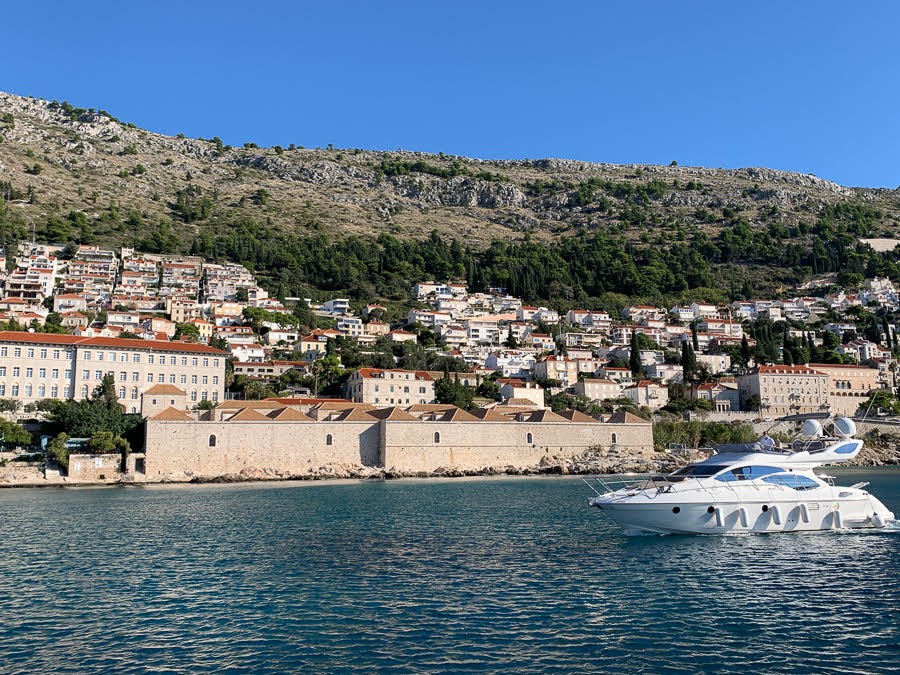
(In the 17th century, Dubrovnik was the largest merchant transit center on the Adriatic and the lazarettos were one of the best organized quarantines in the Mediterranean.)
Story and photographs ©2020, Cyndie Burkhardt. www.photo-diaries.com.
You can follow the latest from Cyndie's column, Croatia Through the Eyes of a Digital Nomad here.
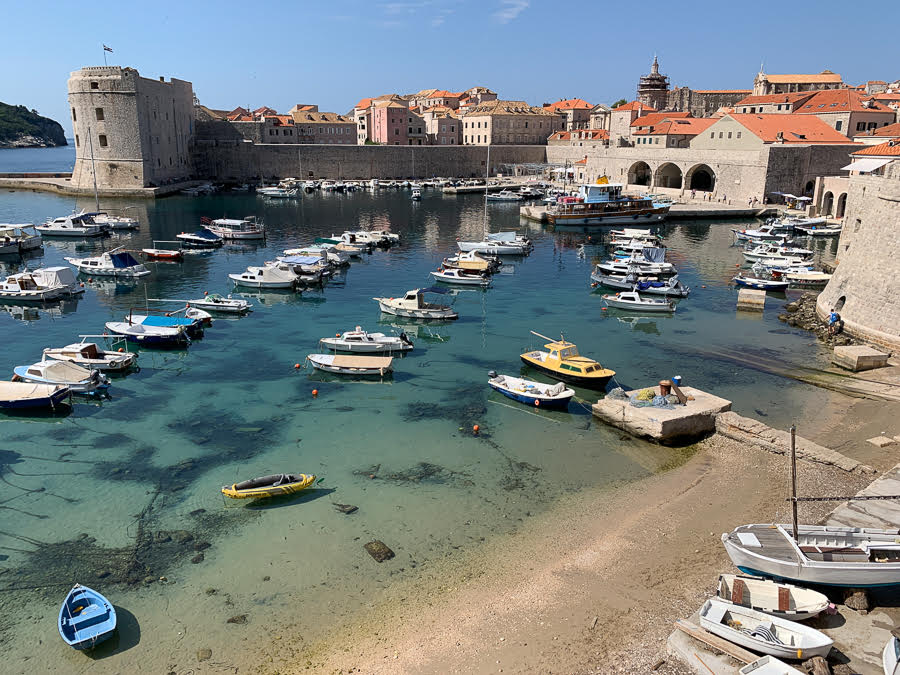
(From the upper courtyard, you get an expansive view of the harbor and the old town.)
For the latest news about digital nomads in Croatia, including that sought-after nomad visa, check out the dedicated TCN digital nomad news section.
Learn more about the Dubrovnik for Digital Nomads conference.

(A large lazaretto on Lokrum, under construction in 1534 was never finished but its remains are still visible. Benedictine monks planted an olive grove in the central courtyard.)
TravelOffPath's Kashlee Kucheran on Croatia's Digital Nomad Potential (Interview)
October 24, 2020 - As the final details of its digital nomad visa are ironed out, a look at Croatia's digital nomad tourism potential from a global perspective via Kashlee Kucheran of TravelOffPath.
It has been a challenging year to be a travel blogger.
Back in March, as Croatia locked down and TCN provided its comprehensive COVID-19 coverage, including daily live updates, life was not much fun. While the information and updates were appreciated by many, writing about death and disease 7 days a week took its toll, quite apart from the challenge of trying to keep on top of the information in a fast-changing situation. And we were only focusing on one country.
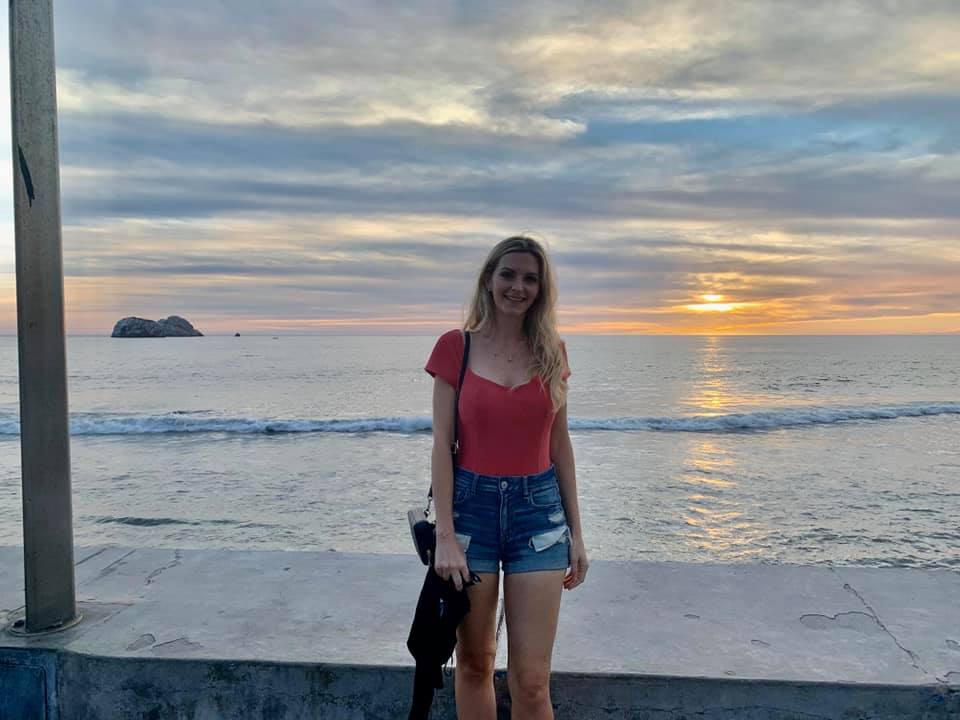
Meet Kashlee Kucheran, a digital nomad with itchy feet, whose TravelOffPath website is growing rapidly in popularity as she focuses on an opportune niche to provide readers with the very latest updates on travel during the corona era. But not for just one country, as we did, but for the whole world.
Keeping such a close eye on the latest developments all over the world, as well as moderating a very active online community for digital nomads looking for the best places to travel to in this strangest of years, Kashlee has a very rounded perspective on current digital nomad trends, interests and preferences. As such, she was invited to be a keynote speaker at the recent Dubrovnik for Digital Nomads conference, where her presentation was one of the highlights of a very entertaining opening day. Read more in "Croatia Has the Potential To Be World's Number 1 Digital Nomad Destination"
I contacted Kashlee after the conference, and she kindly agreed to an email interview about Croatia's digital nomad opportunity.
1. You have been on the road for more than three years, and your successful Travel Off Path blog has become essential reading for digital nomads in the corona era. Tell us firstly when Croatia first came on the radar for you as a digital nomad destination.
Being a digital nomad, I am always on the lookout for new and trendy options to base myself out of for a while. Most of the places nomads frequent are destinations like Thailand, Bali, Vietnam, etc, and as much as I love them all, they all start to blend together. Personally, I have been yearning for a digital nomad destination that has a different feel and scene to it. When I stumbled upon Croatia as a new potential country, I had that “Aha! This is what I’ve been looking for” sort of moment. A country with totally different vibes, from the architecture, to the culture, to the weather, all of which completely appeal to me.

2. During the conference, you stated that interest in Croatia was 'absolutely buzzing' right now. When did you notice the rise in interest in Croatia, and what do you think caused it?
If there was a way I could extrapolate the use of the word ‘Croatia’ being mentioned on my website, in my Facebook groups, and in my DM’s, you would see a graph with a sharp and sudden rise. Croatia has been on the tip of everyone’s tongue lately, especially with American digital nomads, who by the way are a group expected to reach 10 million in size by the end of 2020.
I first noticed the extreme bump in popularity when the rest of the European Union, along with all the South East Asian countries that nomads frequent, shut their doors to most foreign tourists. American, or US citizens, make up the largest group of worldwide nomads, and they found themselves locked out of all their normal go-to destinations. However, Croatia made the bold and progressive decision to allow American tourists, along with all other nations, as long as they came with a negative PCR test, showing they were virus-free.
What happened was a massive surge in stranded tourists making Croatia their destination of choice, since the nation was welcoming them with open arms. We saw people from all over the world, but especially the USA, suddenly changing their itineraries and plans and making their way to Croatia.
3. What advantages does Croatia currently offer the remote worker on the road in these crazy times compared to more established nomad destinations.
Well, the first advantage is that Croatia will actually let them in! Like I mentioned before, Asian countries like Thailand, Vietnam and Bali are all still closed for tourism. Colombia, another up and coming nomad hotspot was closed from March, finally reopening just this month. The choices for nomads is slowly starting to rebound, but still a fraction of what it was pre-pandemic.
Another advantage is cost. The Caribbean nations currently offering digital nomad visas, like Barbados, Bermuda and Anguilla, all have an astronomical cost of living. Bermuda is in fact the most expensive country to live in on the planet, and if there is anything a nomad values, it’s a reasonable cost of living.
Croatia, while still being in the EU, thankfully has a very reasonable cost of living coming in lower than Germany, France, Italy, and even Greece. It also has a much lower cost of living than the countries where most nomads are from, including Canada, the US, Australia, and the UK.
4. Let's imagine life goes back to normal and everything opens, and it is as safe to travel again as before. Would the Croatian nomad beacon still be shining as brightly, or is it largely due to a specific set of circumstances?
If tomorrow the pandemic suddenly ended, and all countries reopened with no restrictions, I still firmly believe that Croatia is still positioned to be one of the top, IF not the top, digital nomad destination.
Some of my reasoning for this include:
Fear of the unknown – Even if the pandemic ended, people are going to be apprehensive about travelling so far from home, to countries that experienced extreme lockdowns. They are going to want to stay a little closer to home, a little closer to first-world health care, and to have easier access to international airports. Heading back down to South East Asia might be overwhelming for many who are concerned about second-waves, re-closures and potentially getting stranded once again.
The romantic European dream – Who doesn’t daydream about sipping wine beside the Adriatic sea, while strolling down cobblestone streets, past ancient ruins, into a cute café to set up their laptop for a few hours work? There is an entire romantic notion about Europe that a lot of nomads, especially ones from the West, fantasize about. Sure, nomads can still land in places like Germany or Italy, but those countries don’t have official/legal nomad programs, limiting the amount of time you can spend there, and technically not permitting you to actually ‘work’ from those locations.
Croatia checks all the boxes – Digital nomads have a mental checklist of what they require in a live/work environment, and Croatia checks all the boxes, including:
- Access to great health care
- Favorable weather
- Good cost of living
- Fast internet speeds
- Connections to major airports
- Accessible entry requirements
- Emerging nomad infrastructure
- Safety
- Trendy culture and community

5. Croatia has announced that it will introduce its own digital nomad visa, planned for early 2021, making it only the second in Europe after Estonia, and the seventh in the world. What advice do you have for the Croatian government about the conditions of that visa? I understand that they will include proof of no criminal record, health insurance, and a regular income which is planned to be lower than the 3500 euro a month in Estonia and $5000 a month in Dubai.
If I had a direct line to the government of Croatia with advice on how to effectively proceed with the framework of the Digital Nomad Visa, it would include these tips:
Make requirements accessible: Find the sweet spot of making the requirements high enough to attract the target nomad, but not too high to discourage growing entrepreneurs. Since Croatia’s cost of living is lower than many EU nations, the minimum monthly income should reflect that.
Keep entry open: Keep Croatia’s doors open to all nations, with PCR testing of course, to ensure that nomads can continue to have faith in making plans to settle in Croatia.
Make the visa affordable: Estonia’s Visa costs only 100 euros, while Georgia’s is free. Keeping the visa under a few hundred Euros is key to attracting nomads. Some Caribbean nations are charging $2000 for a 1-year visa, completely missing the mark. When nomads come, and their entire budget isn’t eaten up with legal formalities, that is just more cash they will inject into the local economy.
Re-consider taxing nomads: Under all the current digital nomad visas being offered worldwide, only ONE of them (Estonia) taxes nomads, and that is only after 6 months of being in the country continuously. If Croatia is considering taxing nomads under their DN visa, I believe the program will crumble. Nomads will instead choose other countries with less restrictive programs, or continue to live/work in countries, mostly in South East Asia, on (albeit technically illegal) terms.
6. During your presentation, you said that Croatia has the potential to be the number one digital nomad destination in the world. And you have yet to visit! You clearly have unique insights due to the website that you run. Why do you believe Croatia can be number 1?
I believe Croatia can be number one because of its great placement in Europe, having less repressively year-round hot weather that many nomads are looking to escape, having a unique culture and history, and of course being drop-dead gorgeous.
It sounds funny to make such a claim about a country I have yet to visit, but being a digital nomad myself for years gives me an insight to what nomad ‘wants’ and ‘needs’ are.
For many years, I chose South East Asian countries because quite frankly that is where everyone went, the DN infrastructure was set up incredibly fast, and there were hardly any other options that offered an actual above-board program. Having options beyond the well-beaten nomad path is a breath of fresh air to this lifestyle.
7. You source information about the latest corona travel restrictions all over the world to help travellers, which must be an exhausting job. How do you source this material to stay up-to-date - both globally and specifically from Croatia.
You’re right! It is an exhausting job, but I love it.
Travelers all over the world are beyond frustrated at the ever-changing travel bans and strange new rules, and I love being able to offer some clarity and assistance in these trying times.
Our team at Travel Off Path work tirelessly every day to get the most up to date information about worldwide travel news, entry requirements, and other vital resources for traveling in a Covid-era world.
We get our information direct from government sources, like embassies, consulates, border police, Ministries and other local authorities, in order to be as accurate and helpful as possible. Sometimes we use local press, like Total Croatia News, who are on the ground and have valuable insights that government sites don’t report on. We also have a Facebook Group where world travelers share their personal experiences around the globe right now, offering first-hand insightful perspectives.
With the information we have been able to consistently source from the Government of Croatia, and local Croatian news, we’ve made in-depth guides how to enter Croatia during Covid, especially for travellers who are locked out of most countries
8. The Dubrovnik for Digital Nomads conference was the first such conference for Croatia. Together with the City of Dubrovnik, Dubrovnik Tourist Board, Tanja Polegubic and her fabulous Saltwater team, and Total Croatia News, we will be organising an international competition for digital nomads to stay for a month in Dubrovnik for free, while helping the city (and wider region) develop a strategy to make it more welcoming and visible to the digital nomad community. During the conference, you said that you would be happy to join us in April. Can we get a confirmation, and how does the prospect of a month in Dubrovnik in April sound right now with you back in British Columbia with the Canadian winter to look forward to?
As you’re interviewing me, I’m looking out the window of my hotel room in Osoyoos, British Colombia Canada, and it’s snowing. As a nomad who hasn’t seen winter in over 5 years, the sound of coming to Croatia in April has me packing my bags with anticipation!
I am overjoyed and delighted to be a part of testing out Croatia’s new digital nomad visa, and I honestly cannot wait to see first-hand what all my readers are raving about.
I have no doubts that Croatia won’t just be a place I visit for 1 month but will most-likely become a part of my future story.
****
Itchy feet in these uncertain times? Follow the latest on where and how to travel with Kashlee Kucheran's TravelOffPath website, or join the TOP Facebook community.
More from the Dubrovnik for Digital Nomads conference:
Croatia Through the Eyes of a Digital Nomad: Croatia Courts the Global Workforce.
Reflections on Croatia's First Digital Nomad Conference in Dubrovnik.
After the Visa, Jan de Jong Announces Croatian Digital Nomad Association.
"Croatia Has the Potential To Be World's Number 1 Digital Nomad Destination"
For the latest about the digital nomad scene in Croatia, follow the dedicated TCN news section.
Flights to Croatia: LOT Operates to Zagreb in November, Dubrovnik Service Canceled
October 23, 2020 - The latest news for flights to Croatia as LOT operates to Zagreb in November and cancels its Dubrovnik service.
Croatian Aviation reports that Polish national airline LOT has announced its flight schedule for November this year. Compared to last year, the company will operate only to Zagreb, and the line to Dubrovnik has been canceled for this year's winter flight schedule.
This summer, LOT Polish Airlines operated on numerous routes from Warsaw and other Polish cities to destinations in Croatia (Zagreb, Rijeka, Zadar, Split, Dubrovnik). Despite the corona crisis, more than 13 new lines have been introduced. Croatia was extremely accessible to Polish tourists by air bridges in this crisis summer season, which is confirmed by the number of arrivals of Polish tourists in the Republic of Croatia this year.
LOT returned to Croatia on July 1, and this summer, it operated on a larger number of routes compared to the summer flight schedule of the previous year.
In the winter flight schedule, which will take effect soon, LOT will keep only one active line to Croatia. Namely, the company plans to operate on the line between Warsaw - Zagreb. Four flights a week have been announced every Monday, Wednesday, Friday, and Saturday. E170 aircraft with a capacity of 70 passengers will operate on the route.
Flights on Wednesdays and Fridays will operate in the morning, while flights on Mondays and Saturdays are announced in the afternoon and evening, respectively.
Although LOT also operated on the Warsaw - Dubrovnik line last winter, this will not happen this winter. Due to the impact of the global pandemic and weak demand, the company has temporarily discontinued this line and plans to operate on it from the spring of next year.
As confirmed to Croatian Aviation from this airline, LOT plans to operate next summer on all routes on which it operated this summer (only the Warsaw - Rijeka route is in question). Still, the decision on the realization of these flights will depend primarily on travel restrictions and demand itself.
Until the spring of next year, LOT will operate regularly only to Zagreb, to a much lesser extent compared to last year's winter flight schedule.
For the latest travel info, bookmark our main travel info article, which is updated daily.
Read the Croatian Travel Update in your language - now available in 24 languages.
"Free 12-Month Dubrovnik Digital Nomad Healthcare" - Glavic Clinic Explains (INTERVIEW)
October 21, 2020 - "Free digital nomad healthcare in Dubrovnik for 12 months." It was certainly the headline of the opening day of Croatia's first digital nomad conference. But what did Glavic Clinic mean exactly? TCN asks the woman who made the commitment, Nikolina Kurtela, Deputy Director of Glavic Clinic.
It was the shortest presentation of the day, one of the funniest, and definitely the one which provoked the most comment as attendees on the first day of the recent Dubrovnik for Digital Nomads conference retired for a well-earned glass of wine after a stimulating opening day.
The slide said it all, and it was hard to misread - All services in Glavic Clinic Dubrovnik - free services for one year to all digital nomads!
Reaction was immediate, both at the conference (wow!) to more skeptical responses on social media.
"One can only imagine what Croatia will charge for the visa if there is free healthcare," commented one. To be clear, this is not a general announcement of free healthcare by every provider in Dubrovnik, it is an announcement from one clinic.
What did it mean exactly, and who can apply for the free services? Rather than try and answer myself, I thought it would make much more sense to ask the lady who made the announcement. I am very grateful to Nikolina Kurtela for finding the time to answer my email questions in search of clarification.
- You gave a presentation on behalf of Glavic Clinic at the recent Dubrovnik for Digital Nomads conference. Tell us firstly why you decided to take part in and be a sponsor in such a conference?
That's right, during the Dubrovnik for Digital Nomads conference, Glavic Clinic participated as a speaker and as a sponsor. Although otherwise as a Polyclinic very much we work in a humanitarian manner and with free work, helping many patients and people in need, event sponsorship is not part of our firm policy. Nevertheless, we recognized the Digital Nomads Conference as a top project connecting proactive and smart people around the world and presenting Croatia, especially Dubrovnik as a city, where one can find a second home and continue to operate a successful business.
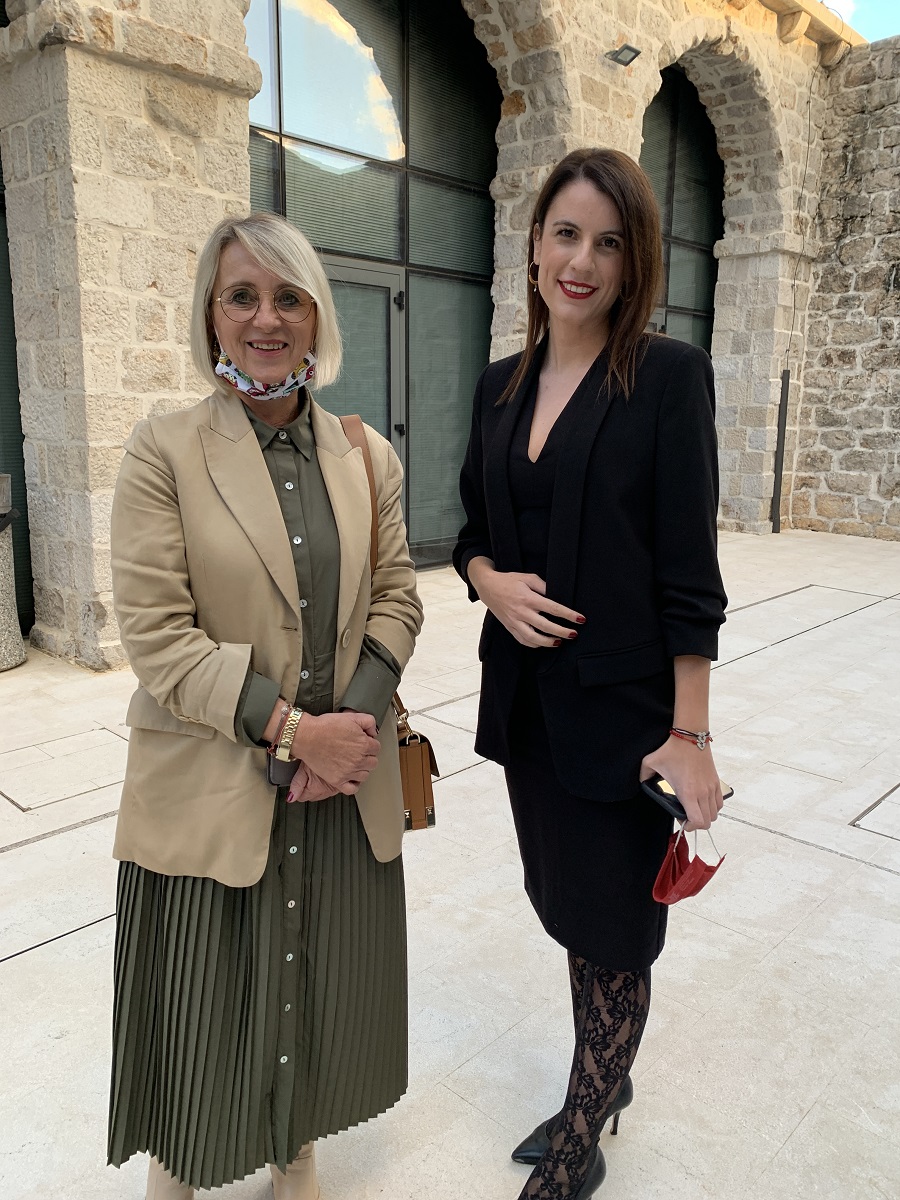
- How much do you know about the digital nomad concept, and how do you see the opportunity for Croatia in general and Dubrovnik in particular?
I have to admit that before Digital Nomads conference I had much less knowledge than now. All the information I had was mostly from the media, but working on the project and the idea throughout preparations for the presentation delighted. In this project, we recognized a great opportunity to help the City of Dubrovnik position itself as a nomad-friendly city that is open to all business people who want to move their home office to one of the most beautiful cities in the world. Dubrovnik is still oriented towards seasonal tourism that lasts 4-5 months, I think this is great way to get to Dubrovnik and we are developing year-round tourism and service provision in Croatia, which would certainly help to preserve a larger number of permanent jobs 365 days a year.
- And now tell us more about THAT announcement. Free 12-month healthcare for digital nomads coming to Dubrovnik. Are you crazy? Some initial reaction to this is that this is some kind of scam to grab publicity.
Hahaha, I think a little craziness is always good in life, but I would like to mention the „main man role“ for this "crazy idea" is being played by the director of Glavic Clinic dr. Joško Glavić. During our conversations about the Digital Nomads project, he said he wanted to do something special and help all the nomads who choose Dubrovnik as their base feel welcome and safe in the healthcare segment that we know is often the biggest concern for all travelers and foreign nationals.
No, the idea is not a scam or an attempt to grab publicity because it is commonly known that as a Polyclinic, we normally avoid being in the media. The idea is just a continuation of our humanitarian work and helping people, in this case digital nomads.
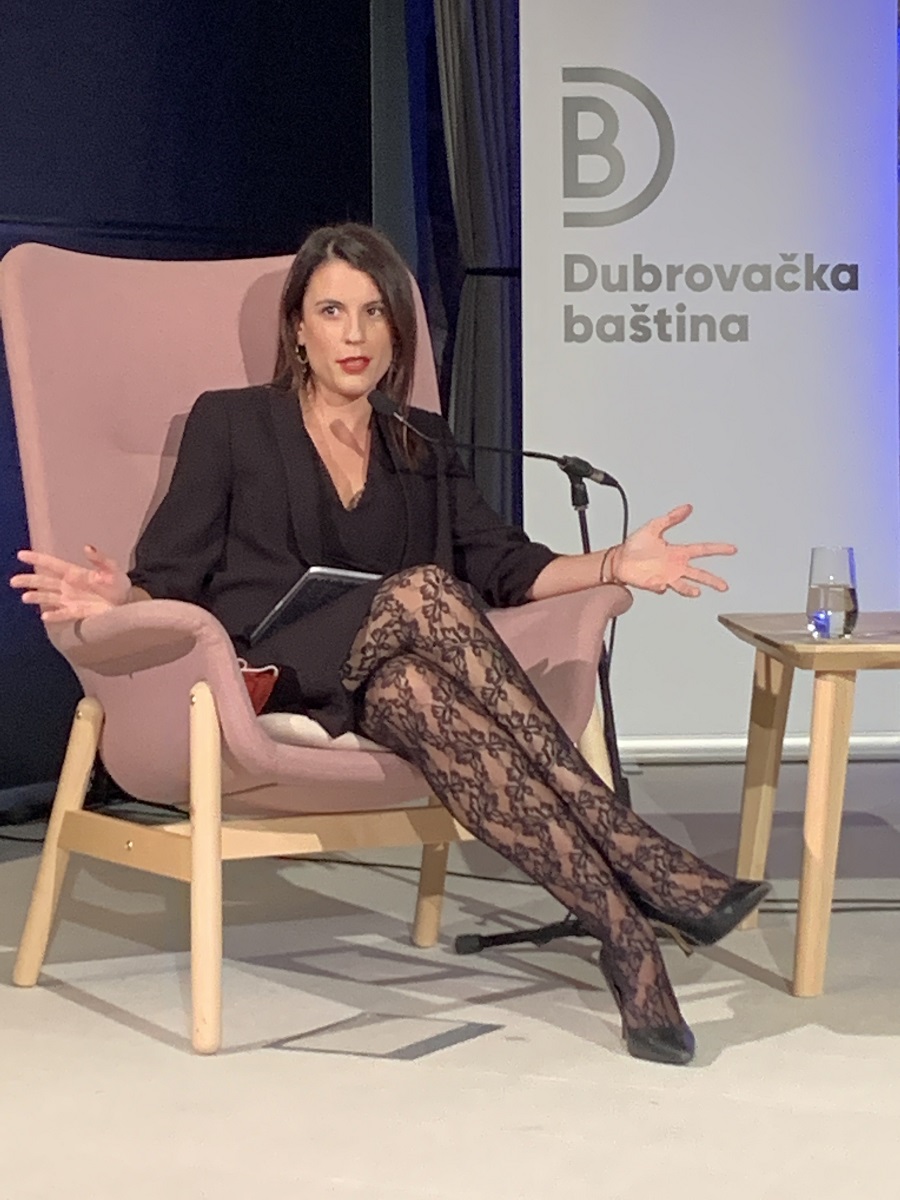
- It sounds a great headline. Please clarify EXACTLY what you mean, and what digital nomads have to do to qualify? Is it just for nomads in Dubrovnik or elsewhere?
Therefore, in order to exercise the right to free services at the Glavic Dubrovnik Polyclinic, Digital nomads must have a visa for digital nomads and choose Dubrovnik as their place to live for a year during which they will have all our services available free of charge. (Editor note: the visa is expected to be available in the first quarter of 2021.)
- Glavic Clinic has a reputation for humanitarian acts. Tell us a little about that, as well as the services you offer, and your European expansion plans.
Glavić Clinic is the only clinic in this part of Europe that deals with robotic neurorehabilitation patients with neurological impairments and movement and motor difficulties in most commonly diagnosed cases with cerebral palsy, stroke, spinal cord injury, trauma heads and numerous others. Aware that we live in a part of Europe that is not the strongest in terms of income and that we have many economically vulnerable citizens, we want this concept treatment to be available to all.
Precisely because of that, in both centers, and it will be the same in the new centers, 30% of our patients are in a completely free program and they are being rehabilitated without payment, besides that during the year we organize 2-3 major charity actions. Health is wealth and that is why we try to provide it to the most endangered patients and there are our patients in the humanitarian program from Croatia and neighboring countries are often orphans, homeless people, national minorities, etc.
Given the uniqueness of the treatment concept and the successful results, due to which we are known as a reference center for the EMEA region, we want to expand our business beyond Croatia and we are currently in the process of leading the opening project in Madrid and Amsterdam as well as the USA. But unfortunately, as with everyone else, the Covid pandemic has slowed us down and made our travel and operational work more difficult. We are sure that by expanding abroad and in our foreign clinics we will benefit services of Digital Nomads and continue the chain of connecting and networking smart and capable people.
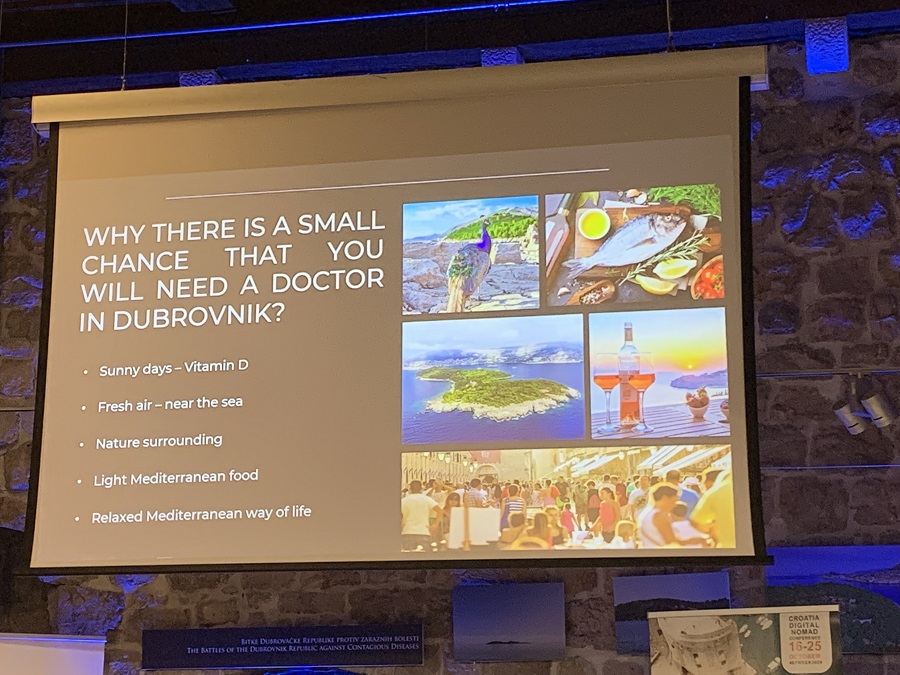
- This was the first-ever digital nomad conference in Croatia. Tell us how it was for you - what struck you the most?
This conference, for me was a wonderful experience where I met a lot of smart and enthusiastic people who are certainly one of the drivers of change in the world. I was most struck/suprised by all the positive energy and preparedness of the system and the Republic of Croatia to really attract digital nomads to our country and show them all the beauties of life in Croatia, which I partly explained to you in the presentation.
You can learn more about the services of Glavić Clinic on the official website. I am sure they would be happy to answer your digital nomad healthcare questions as well.
More from the conference:
Croatia Through the Eyes of a Digital Nomad: Croatia Courts the Global Workforce.
Reflections on Croatia's First Digital Nomad Conference in Dubrovnik.
After the Visa, Jan de Jong Announces Croatian Digital Nomad Association.
"Croatia Has the Potential To Be World's Number 1 Digital Nomad Destination"
For the latest about the digital nomad scene in Croatia, follow the dedicated TCN news section.


